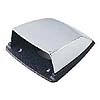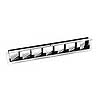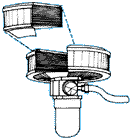Required Equipment
PFDs, Flares Fire Extinguishers, Sound Devices and Lights
To legally operate your vessel, both the Coast Guard and the states require you to carry certain equipment aboard your boat. These requirements are generally based upon the length of your boat, but a recent trend has been to have requirements based upon the time of year that you operate your vessel, or how far from shore you might operate your vessel. For example, boats 16 feet in length and over must have the at least:
- One personal flotation device (in good condition) for each person on board, plus a throw-able cushion or ring is required. You must have the PFDs out of the plastic and in a READILY accessible location. The throw-able should be close by the steering station. For more information on PFD's, click here.
- Three current-dated, hand-held, approved flares are minimum equipment to serve for day and night distress signals, both inshore and offshore. For more information on Visual Distress Signals, click here.
- The correct number of approved fire extinguishers, readily available for use is based on the size of your vessel. For more information on fire extinguishers, click here.
- A sound making device. For more information on sounds, click here.
- Working running lights. For more information on lights, click here.
Ventillation Systems
If you have enclosed areas on your boat, a ventilation system can do many things for you. If you have any gasoline powered engines aboard a ventilation system is a legal requirement. Good ventilation can do many things for you--help prevent mildew and bad odors, to saving your life by taking carbon monoxide and gasoline fumes out of the boat.
Ventilation systems must have two parts--an air inlet, and a separate air outlet. Both the inlet and the outlet must have ducts--which are tubes or hoses that extend down into the boat. Ducting for the exhaust must be located in the lower third of the hull--but above any bilge water. Ducting should be routed away from any heat sources, should not be "kinked", and should be inspected regularly for cracks or debris. (Birds like to make nests in ducts.) Intakes are usually pointed forward, exhausts usually face aft.
Boats must have a ventilation system that is adequate for the size space the system is used for. Larger boats with larger compartments must have more ventilation--the figure is 15 square inches of opening for each cubic foot of compartment. For most boats that works out to having two inlets and exhausts, with each vent having ducting from 3 inch diameter hose for smaller boats to 5 inch hose for larger boats.
Natural Ventilation

A natural, or passive, ventilation system consists of vents, cowls and other permanent openings in the boat that are designed to let air enter or exit using wind power or the boats' motion to move the air.

This type of system is rather ineffective at clearing fumes when the boat is not in motion, so it used primarily for living spaces and tank/bilge areas. It can be used in engine compartments, but only in conjunction with powered blowers.
Power Blowers / Vents

A bilge blower is important not only because it's required, but because your life may depend on it. The USCG stipulates the use of a mechanical ventilation system for all non-open boats built after July 31, 1981 that run on gasoline.
Even if your boat is older, it still must conform to USCG minimum ventilation levels, and may require a bilge blower to satisfy those guidelines.

Bilge Blowers are specifically designed to clear gasoline fumes from closed compartments. They are ignition protected to prevent sparks, and are built to resist overheating and corrosion. The size blower you need is determined by the volume of your engine compartment. It is recommended that you use a blower at least 4 minutes before you ever start the engine, and especially after fueling.
Backfire Flame Arrestor

With some minor and technical exceptions, every inboard gasoline engine must be equipped with an acceptable means of backfire flame control-or "flame arrestor." This safety device prevents an exhaust backfire from causing an explosion. It operates by absorbing heat.
Flame arrestors no longer require Coast Guard approval; the USCG now accepts flame arrestors complying with Underwriters Laboratories Standard 1111 or Society of Automotive Engineers J1928. When in use flame arrestors must be secured to the air intake of the carburetor with an airtight connection. Elements must be clean, and grids must be tight enough to prevent flames passing through. Cleaning with soap and water is the best way to maintain its effectiveness.
Equipment Chart
| U.S. COAST GUARD MINIMUM EQUIPMENT REQUIREMENTS | ||||
|---|---|---|---|---|
| Equipment | Boats less than 16 feet | 16 to 26 feet | 26 to 40 feet | 40 to 65 feet |
| Personal Flotation Devices | Recreational boats must carry Coast Guard approved Personal Flotation Devices, in good and serviceable condition, and of the appropriate size for the intended user. Wearable PFDs must be readily accessible, not stowed in bags, locked or closed compartments or have other gear stowed on top of them. Throwable devices must be immediately available for use. There must be one Type I, II, III, or V PFD for each person on board or being towed on water skis, etc., PLUS one Type IV throwable device. Throwable, Type IV PFDs may no longer be substituted for wearable types on boats less than 16 feet. State laws on mandatory PFD wear may vary. | |||
| Fire Extinguishers* | At least one B-1 type (see below) Coast Guard-approved hand portable fire extinguisher. Not required on outboard boats less than 26 feet long and not carrying passengers for hire if the construction of such motorboats will not permit the entrapment of explosive or flammable gases or vapors, and if fuel tanks are not permanently installed. | At least two B-1 type approved portable fire extinguishes; OR at least one B-2 type.. | At least three B-1 type approved portable fire extinguishers; OR at least one B-1 type PLUS one B-2 type. | |
| Visual Distress Signals | Must carry approved visual distress signals for nighttime use. | Must carry visual distress signals approved for daytime and nighttime use. For pyrotechnic devices (hand-held or aerial red flares, floating or hand-held orange smoke, and launches for aerial red meteors or parachute flares) a minimum of three required, in any combination that totals 3 for daytime and 3 for night use. Three day/night devices will suffice. Devices must be in serviceable condition, dates not expired and stowed accessibly. Exceptions are open sailboats less than 26 feet long and not equipped with propulsion machinery, and manually propelled boats; both required to carry only night signals. | ||
| Sound Device | Every vessel less that 39.4 feet (12 meters) long must carry an efficient sound-producing device. | Every vessel 39.4 (12 meters) long, but less than 65.6 feet (20 meters) must carry a bell and a whistle. | ||
| Ventilation (boats build after April 25, 1940) | At least two ventilator ducts fitted with cowls or their equivalent for the purpose of properly and efficiently ventilating the bilges of every closed engine and fuel tank compartment of boats constructed or decked over after April 25, 1940, using gasoline as fuel and other fuels having a flashpoint of 110° F or less. | |||
| Ventilation (boats build after August 1, 1980) | At least two ventilator ducts for the purpose of efficiently ventilating every closed compartment that contains a gasoline engine and every closed compartment containing a gasoline tank, except those having permanently installed tanks vented outside the boat and containing no unprotected electrical devices. Also, engine compartments containing a gasoline engine with a cranking motor must contain power-operated exhaust blowers controllable from the instrument panel. | |||
| Backfire Flame Arrestor | One approved device on each carburetor of all gasoline engines installed after April 25, 1940, except outboard motors. Device must be marked to show compliance with SAE J-1928 or UL 1111 Standards. | |||
| * When fixed fire-extinguishing system is installed in machinery spaces, it will replace one B-1 type portable fire extinguisher. | ||||
Coast Guard minimum equipment requirements vary with the size of the boat, type of propulsion, whether operated at night or in periods of reduced visibility, and, in some cases, the body of water on which it is used. For a more thorough discussion and complete details on how many and what types of equipment you must have aboard your boat, request a free copy of the pamphlet "Federal Requirements for Recreational Boats' from the Coast Guard. For more information visit www.uscgboating.org, and many local marine retailers have printed copies available in store at no charge. Many state requirements go beyond Coast Guard requirements. Contact your state boating office for details.
Recommended Equipment
Coast Guard minimum requirements are just that, minimum. It is suggested you carry additional safety equipment, such as:
- Anchor with sufficient line/chain (at least five times water depth)
- Bailer (bucket)
- Oars or paddles
- First aid kit
- VHF radio
- Extra fuel & water
- Tool kit
- Sun protection
- Flashlight

